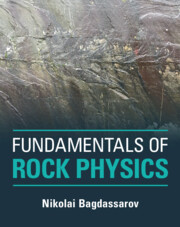Book contents
- Fundamentals of Rock Physics
- Fundamentals of Rock Physics
- Copyright page
- Dedication
- Contents
- Preface
- 1 Introduction
- 2 Density and Porosity
- 3 Stresses in Rocks
- 4 Mechanical Strain and Elastic Moduli
- 5 Permeability of Rocks
- 6 Mechanical Properties of Fluid-Bearing Rocks
- 7 Acoustic Properties of Rocks
- 8 Electric Resistivity
- 9 Dielectric Properties
- 10 Magnetic Properties of Rocks
- 11 Thermal Properties of Rocks and Minerals
- 12 Radioactive Properties of Rocks
- Index
- References
7 - Acoustic Properties of Rocks
Published online by Cambridge University Press: 19 November 2021
- Fundamentals of Rock Physics
- Fundamentals of Rock Physics
- Copyright page
- Dedication
- Contents
- Preface
- 1 Introduction
- 2 Density and Porosity
- 3 Stresses in Rocks
- 4 Mechanical Strain and Elastic Moduli
- 5 Permeability of Rocks
- 6 Mechanical Properties of Fluid-Bearing Rocks
- 7 Acoustic Properties of Rocks
- 8 Electric Resistivity
- 9 Dielectric Properties
- 10 Magnetic Properties of Rocks
- 11 Thermal Properties of Rocks and Minerals
- 12 Radioactive Properties of Rocks
- Index
- References
Summary
Acoustic properties of rocks relate alternating stresses of varying frequency and elastic strains. In solids there are longitudinal and transversal waves, whose propagation is described by the wave equation. Longitudinal velocity Vp correlates with density and mean atomic weight of rocks. For rocks with a similar mean atomic weight there is a linear dependence of acoustic impedance Z vs. Vp. As a function of porosity, Vp may be estimated from modified Hashin-Shtrikman bounds. For sands and cemented sandstones the models of Dvorkin and Nur are applicable. Propagation velocities of elastic waves in rocks decrease with increasing temperature and increase with increasing pressure. To describe viscoelastic behavior of rocks, the concept of complex elastic moduli is used. Inner friction in rocks depends on temperature, pressure, porosity and pore saturation. Absorption coefficient and quality factor of rocks are frequency dependent. Rocks possess elastic intrinsic and extrinsic anisotropies. Anisotropy of elastic waves in minerals may be represented using pole diagrams. Focus Box 7.1: Models of sandstones after Dvorkin & Nur. Focus Box 7.2: Christoffel matrix and elastic wave velocities.
Keywords
Information
- Type
- Chapter
- Information
- Fundamentals of Rock Physics , pp. 245 - 291Publisher: Cambridge University PressPrint publication year: 2021
